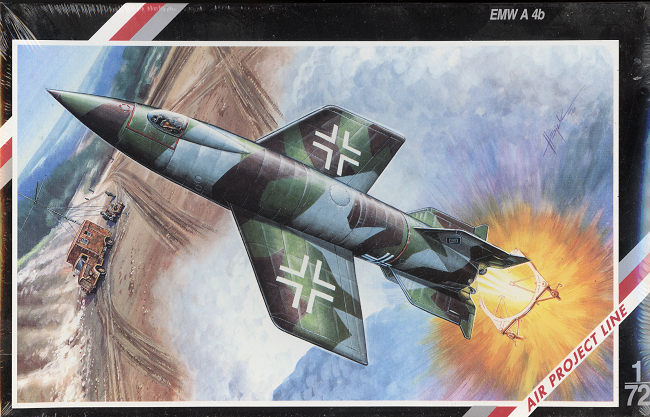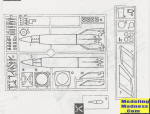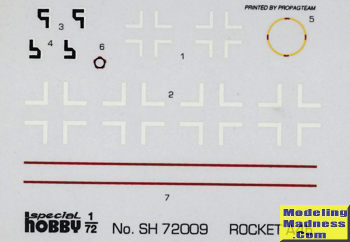
| KIT #: | SH 72010 |
| PRICE: | $11.99 when new |
| DECALS: | One option |
| REVIEWER: | Scott Van Aken |
| NOTES: | Short run with vacuform canopy |

| HISTORY |
In anticipation of the possibility that launch sites might be forced back into the Reich itself, von Braun and his colleagues were put under pressure to develop a longer-range version of the A4 known alternatively as A9 and A4b, the reason for the dual designation being that the A4 series had received "national priority"; the A4b designation ensured the availability of scarce resources.
In June 1939, Kurt Patt of the Peenemünde Design Office, proposed wings for converting rocket speed and altitude into aerodynamic lift and range. As the rocket encountered thicker atmosphere on its descent phase, it would execute a pullout and enter a shallow glide, trading speed for distance. Patt also proposed the Flossengeschoss (fin projectile). Both concepts were utilized by Walter Dornberger when he drafted a memo for presentation to Hitler regarding the "America rocket" on July 31, 1940.
Design studies on the A9 began in 1940. In addition to its wings, the A9 would have been somewhat larger than the A4 and its engine would have produced about 30% more thrust. Following wind tunnel testing of models, the design was subsequently modified to replace the wings with fuselage strakes, as the tests showed that these provided better lift at supersonic speeds and also solved the problem of transonic shift of the centre of lift.
Development was suspended in 1941, but in 1944 several V-2s were modified to an approximation of the A9 configuration under the designation A4b. It was calculated that by fitting wings, the A4's range would be extended to 750 km (470 mi), allowing targets in Britain to be attacked from launch sites within Germany itself. It was intended that following launch the curve of the A4b's trajectory would become shallower and the rocket would glide toward its target. It was anticipated that interception by enemy aircraft at the end of the glide phase would be virtually impossible as over the target the A-4b was intended to enter a near vertical dive leaving little time for interception.
The A4b concept was tested by fitting swept back wings to two A4s launched from Blizna. Little development work had been carried out and the first launch on 27 December 1944 was a complete failure. The second launch attempt, on 24 January 1945, was partially successful, in that the wing broke off, but the A4b still managed to become the first winged guided missile to break the sound barrier and attain Mach 4.
| THE KIT |
 The
origin of the 'Luft 46' craze in terms of kits is still a bit fuzzy, but along
with Planet Models, Special Hobby sure seems to have taken it to heart as most
of their initial kits were of this genre. This is a fairly standard short run
kit that has finely engraved panel lines, a small amount of flash, and fit that
was generally considered 'dodgy'. This required a modeler to have at least a
modicum of skills in terms of dealing with the inevitable issues of getting
things to look right.
The
origin of the 'Luft 46' craze in terms of kits is still a bit fuzzy, but along
with Planet Models, Special Hobby sure seems to have taken it to heart as most
of their initial kits were of this genre. This is a fairly standard short run
kit that has finely engraved panel lines, a small amount of flash, and fit that
was generally considered 'dodgy'. This required a modeler to have at least a
modicum of skills in terms of dealing with the inevitable issues of getting
things to look right.
There is a rudimentary cockpit which has a floor, forward and aft bulkhead, seat shape and control stick. The rocket body itself needs to have the standard control vanes on the fins removed and replaced with larger versions. After closing the fuselage halves, one attaches the vacuform canopy. The additional fins and wings are butt joins with areas on the fuselage etched to show their location. That is it for the airframe.
Most of the parts count is dedicated to the launching
platform. This is a fairly complex structure and where the little bits are
concentrated. Special hobby has provided several drawings of this item to ensure
 that you
get things properly aligned. This platform has an upper and lower section with
the upper section simply fitting into the lower so one can move the upper
section in azimuth.
that you
get things properly aligned. This platform has an upper and lower section with
the upper section simply fitting into the lower so one can move the upper
section in azimuth.
Instructions are well done for the time and there are markings for a single option. This is in a rather colorful splinter camouflage of RLM 76/81/83. The launch platform is to be painted RLM 79. Of course, you can paint these items any shade you want and personally I'd go with RLM 02 or black for the launching platform. The decal sheet is nicely printed and provides swastikas in pieces as is the norm.
| CONCLUSIONS |
Despite the supposed demise of Luft '46, there is still an active community of enthusiasts for the subject and this kit fits well into that mold. While I'm sure it will not be an easy build, it will produce an interesting subject for your display shelves.
| REFERENCES |
https://en.wikipedia.org/wiki/Aggregat_(rocket_family)
November 2018
Copyright Modeling Madness.com. All rights reserved. If you would like your product reviewed fairly and
fairly quickly, please
contact
the editor or see other details in the
Note to
Contributors. Back to the Main Page
Back to the Review
Index Page
Back to the Previews Index Page